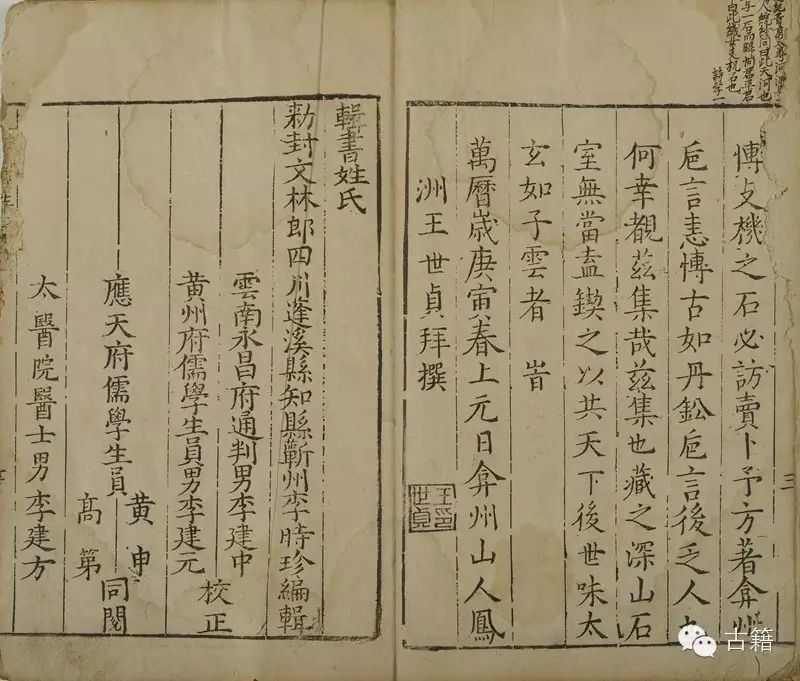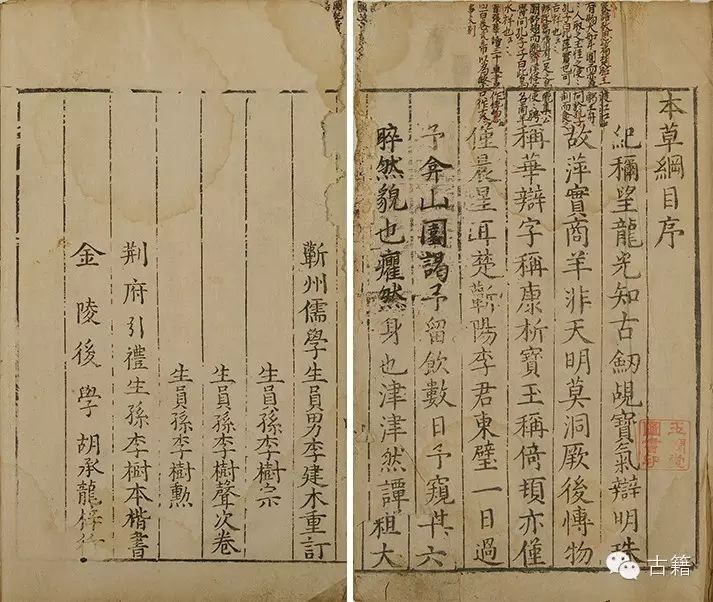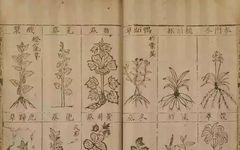

2015 Xiling Spring Auction
The Compendium of Materia Medica (Zuben)
Compiled by Li Shizhen (明)
Published in the 18th year of the Wanli era (1590) by Hu Chenglong in Jinling
21 volumes, cotton paper
Collection seal: Yurun Tang Library Seal (red)
Half frame: 19.3×14.3cm, open size: 26.1×16.3cm
Summary: This is the first printed edition of the ancient Chinese materia medica classic “The Compendium of Materia Medica”, known as the “Jinling edition”, which is the most faithful version to Li Shizhen’s original work among over 100 versions of the text, possessing significant historical and academic value. This version is only held in public collections at the Shanghai Library and the China Academy of Chinese Medical Sciences, and is rarely circulated among the public.
“The Compendium of Materia Medica” consists of 52 volumes, divided into 16 sections and 60 categories, documenting 1892 medicinal substances, with 11096 prescriptions and 1110 illustrations. It is Li Shizhen’s magnum opus, compiled over thirty years. The book meticulously verifies and examines the content discussed in ancient materia medica, based on his own experiences and firsthand data collection, emphasizing the integration and application of medicine, incorporating knowledge from botany, zoology, mineralogy, metallurgy, geology, chemistry, phenology, astronomy, geography, and agriculture, and has been praised by Darwin as “the encyclopedia of ancient China”.
After completing the manuscript, Li Shizhen attempted to publish it through various channels, but was rejected due to funding or market reasons, until in 1590 he met Wang Shizhen again to request a preface. Wang Shizhen praised the book as “broad yet not verbose, detailed yet essential, comprehensive and profound, truly reflecting the essence of nature and the principles of things”, leading the Jinling bookseller Hu Chenglong to decide to publish it, which took four years, and is known as the “Jinling edition”. After its release, it received a strong social response, and three representative reprints emerged: the 31st year of Wanli by Jiangxi Governor Xia Liangxin (“Jiangxi edition”), the 13th year of Chongzhen by Hangzhou’s Qian Weiqi (“Hangzhou edition”), and the 11th year of Guangxu by Hefei’s Zhang Shaotang (“Hefei edition”). Although these reprints surpassed the “Jinling edition” in printing quality, they contained many omissions and errors in content. For example, in volume four, “External Injuries and Sores”, the term “cracking” was used as a subheading in the “Jinling edition”, while the “Jiangxi edition” mixed it into the end of the “frostbite” section, leading to a significant change in meaning, turning a remedy for cracking into one for frostbite. Such errors have persisted in later reprints, highlighting the value of the original Jinling edition.
This edition has twelve lines per half leaf, with twenty-four characters per line, and single-sided margins. It includes a preface by Wang Shizhen from the 18th year of Wanli (with omissions), a list of contributors, and two volumes of illustrations. The “list of contributors” is not included in later editions, detailing the individuals involved in the publication of the “Jinling edition”: Li Shizhen, the editor, was the county magistrate of Pengxi, Sichuan; Li Jianzhong, the deputy magistrate of Yongchang, Yunnan; Li Jianyuan, a student from Huangzhou, served as proofreader; Huang Shen and Gao Di, students from Yingtian, reviewed the work; Li Jianfang, a physician from the Imperial Medical Institute; Li Jianmu, a student from Jingzhou, revised the work; and several students contributed to the final volume. It is evident that the “Jinling edition” was a family effort by Li Shizhen.
The complete work consists of fifty-two volumes, of which this edition retains forty-two volumes, missing volumes one to three, five to eight, sixteen, thirty-one, thirty-two, thirty-three. It is well-preserved.
The Birth of the Compendium of Materia Medica
“The Compendium of Materia Medica” is the longest and most comprehensive pharmacological work in the history of ancient Chinese medicine.
The “Jinling edition” of “The Compendium of Materia Medica” was the first printed edition after its completion, overseen by Li Shizhen during his lifetime, reflecting the author’s original intentions, with illustrations created by Li Shizhen and his son. The complete work consists of fifty-two volumes, of which this edition retains forty-two volumes, well-preserved.
• Tasting Hundreds of Herbs, Thirty Years to Completion
Li Shizhen had a broad reading horizon, so in the initial compilation of “The Compendium of Materia Medica”, it transcended the general significance of materia medica literature, existing as a work of natural history. On one hand, he needed to scrutinize the errors of old texts, while on the other, he conducted pharmacological experiments and engaged in field investigations to supplement new content. As a scholar-type physician, while treating officials, he also seized opportunities to access rare literature. Due to his training in traditional philology, “The Compendium of Materia Medica” even became an important work for exploring etymology and related terminology, as can be fully appreciated from the section “Explaining Names” in the book.
• Creative Classification Method with a Framework
From the 14th to 17th centuries, both Chinese and European materia medica achieved significant developments. As a representative figure of early “artificial classification systems” in plant taxonomy, Li Shizhen adopted the method of “analyzing families and categorizing species” in “The Compendium of Materia Medica”, changing the traditional three-tier classification of upper, middle, and lower grades, thus laying the foundation for modern plant taxonomy, predating the Swedish botanist Linnaeus by over 100 years. The renowned scholar Joseph Needham, during his exploration of Chinese culture, regarded Li Shizhen’s classic work “The Compendium of Materia Medica” as an indispensable guide for studying the history of Chinese scientific development.
• A Decade of Prefaces, The Hard Road to Independent Publication
After finalizing the manuscript, Li Shizhen went to Nanjing, the largest printing center in the country at the time, seeking publication opportunities. However, private publishing houses showed little interest in medical books. The book contained content that opposed Taoist immortality, which also caused considerable trouble in the cultural context of the time. In the autumn of 1580, Li Shizhen visited the literary leader Wang Shizhen, expressing his desire for a word of endorsement to ensure immortality, but unfortunately, it did not yield results. It was not until ten years later, at the age of 73, that Li Shizhen was invited to meet Wang Shizhen again, who, after reading it carefully, wrote a highly praised preface.
• The Jinling Edition Emerges, Spreading Worldwide
Due to Wang Shizhen’s reputation for not giving undue praise, his high regard for “The Compendium of Materia Medica” led the Jinling bookseller Hu Chenglong to decide to publish the book. In 1593, the printing plate of this historic medical masterpiece was finally completed! Li Shizhen left the world without regrets. In 1596, “The Compendium of Materia Medica” was officially published, known as the “Jinling edition”. In the same year, Emperor Shenzong personally approved, “The book is for review, the Ministry of Rites is informed, thus decreed.” In 1606, “The Compendium of Materia Medica” was introduced to Japan, and later translated into more than ten languages including Japanese, Korean, French, German, English, Latin, and Russian, spreading throughout the world. In 2011, the “Jinling edition” of “The Compendium of Materia Medica” successfully entered the UNESCO Memory of the World Register.

